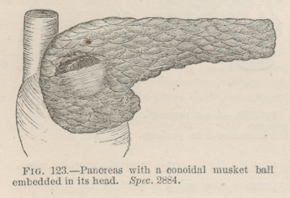Title: B——, William P.
Source text: The Medical and Surgical History of the War of the Rebellion. (1861-65.), Part 2, Volume 2 (Washington, DC: Government Printing Office, 1876), 160-161.
Civil War Washington ID: med.d2e31473
TEI/XML: med.d2e31473.xml
CASE 418.—Private William P. B——, Co. A, 44th Georgia, was wounded, near Fort Stevens, in General Early's demonstration on Washington, July 12, 1864, by a cylindro-conical musket ball, which entered below the spine of the left scapula, an inch from the shoulder-joint, and penetrated the chest. He remained a prisoner on the field, and was conveyed to Lincoln Hospital, a few miles distant, being admitted on July 14th. Acting Assistant Surgeon Thaddeus L. Leavitt, the ward surgeon, noted that emphysema extended over the entire left chest, that respiration was painful, but not otherwise difficult, and that there was paralysis of motion of the left arm. Simple water dressings to the wound, and a draught with an eighth of a grain of sulphate of morphia in syrup of seneka and wild-cherry bark thrice daily, with extra light diet and a little wine. There was little change in the progress of the case until the 18th, when the pain in the side became great, and was somewhat relieved by sinapisms. There was dulness on percussion, and absence of the respiratory sounds over the posterior left chest. Anteriorly, percussion and auscultation normal. On the 19th, there was extreme dulness in the præcordial region, and the head was forced over to the right side. There was dulness, too, at the base of the right lung, with indistinct respiratory murmur. On the 20th, jaundice was very pronounced, and Dr. Leavitt enters on the register: "Can the liver be injured also?" On the 21st, at 4 o'clock A. M., profuse hæmorrhage from the nose and mouth occurred; bleeding coming apparently from the lung. The local pain was much lessened, the pulse became very weak and thready; the jaundice was extreme; chloride of sodium ordered. On the 22d there was much pain in the left side, dyspnœa, consciousness perfect, pulse failing; death at noon, July 24, 1864. At the autopsy, two hours after death, the wound was traced from the entrance in the scapula through the fractured fifth rib, the track passing downward, inward, and backward, through the lower lobe of the left lung, the diaphragm, the left lobe of the liver to the head of the pancreas, where the ball was found lodged in the head of the viscus, at the angle formed by the cœliac axis with the aorta. The lower lobe of the right lung was hepatized; the left lung was carnified, collapsed, and compressed by a large accumulation of black fluid blood. The pleura was freely lined with partly organized lymph. The heart was normal; its cavities empty, weight nine ounces. The spleen was firm, dark brown, weight nine and a half ounces. The pancreas was rather large, seven inches long; weight, five ounce, (weighed with the ball embedded). There was nothing abnormal in its appearance, except the presence of the foreign body. The specimen was sent to the Museum by Acting Assistant Surgeon H. M. Dean, with a memorandum of the autopsy and the clinical "descriptive list," drawn up by Dr. Leavitt. In the latter, there is no indication of any symptoms calling attention to the pancreas during the eight days the patient was under observation. Indeed it was not until the sixth day from the reception of the injury that the hæmorrhage and jaundice led to the suspicion of the hepatic lesion. Unfortunately, the appearance of the dejections is not noted. On examining the specimen microscopically, no deviation from the normal structure is found in sections made from tissue taken from the left end or tail of the viscus, and from the middle part or body. In close contiguity to the ball is a fine network of fibrillated tissue. As hardened in alcohol, the preparation offers no indication of vascular engorgement having existed. The coats of the great arteries with which the ball was in apposition were uninjured.¹
¹ HIPPOCRATES nowhere mentions the pancreas. VESALIUS (De hum. corp. fab., L. V, cap. IV, ed. Basileæ, 1542, p. 494) held the opinion of the earlier anatomists, that its office was to underlie the stomach as a pillow, a view refuted by its position in birds and fish, remote from the stomach. A BACCIUS (Romæ, 1586) maintained that it served for the transit of the chyle from the intestines to the spleen. After the discovery of the pancreatic duct, in 1642, by WIRSUNG, VESLINGIUS (Syntagma anat., 1664, cap. IV) held that the pancreatic fluid resembled bile, a view supported by ASELLI and RIOLAN. BARTHOLIN regarded the pancreas as the excretory duct of the spleen. A pupil of SYLVIUS, DE GRAAF (De succo pancreatico, Lugduni Bat., 1671), extirpated the spleen in dogs to refute this view. A fifth opinion, assigned to LINDENUS (Leyden, 1664), was that the pancreas excreted the effete dregs of the blood. A sixth doctrine taught that it carried off the excretions of the nerves. SYLVIUS (Thes. 37) enunciated the true doctrine, that it furnished an important secretion of its own. After many researches by BRUNNER (Exp. nov. circa Pancreas, Amsterdam, 1683), PECHLIN (Leyden, 1672), and others, HALLER, after exhausting himself in conjectures, could only say: Plura possunt esse officia liquoris nondum satis noti; and MAGENDIE, fifty years later, admitted that the function of the pancreatic fluid was unknown. In 1823, the Academy of Paris made this a prize question, and the analyses of TIEDEMANN and GMELIN, and of LEURET and LASSAIGNE, received honorable mention, and paved the way for the great discoveries of CLAUDE BERNARD, which, however qualified by the criticisms of FRERICHS and of BIDDER and SCHMID, must stand in the main.
